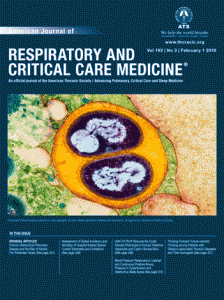 An investigation at Johns Hopkins University has uncovered several issues with the figures in two papers on a lung disease linked to smoking, one of which is highly cited.
An investigation at Johns Hopkins University has uncovered several issues with the figures in two papers on a lung disease linked to smoking, one of which is highly cited.
The American Journal of Respiratory and Critical Care Medicine is retracting both papers, which examine the role of protein NRF2 in chronic obstructive pulmonary disease. But both contain spliced and duplicated figures, among other issues.
Both papers — which share a total of five authors — received an expression of concern in 2014, after the corresponding author noticed anomalies in the figures. That same year, PubPeer commenters had begun raising questions about some of the figures in one of the papers.
A spokesperson for Johns Hopkins declined to say whether the investigation considered if the errors were the result of misconduct.
All authors agreed with the retraction, except for one who couldn’t be located. Here’s more from the retraction note for both papers:
The authors provided the Journal with a statement that includes results from an official investigation conducted by the Johns Hopkins School of Public Health. The statement enumerates problems with figures in the 2008 article (1). It states that Figures 1C and 2B contain separate blot images spliced together to represent one image without appropriate demarcation. Additionally, Figures 1C and 2B, representing two different experiments, contain the same glyceraldehyde phosphate dehydrogenase (GAPDH) panel. Figures 5A and 5D, representing two different experiments, contain portions of the same GAPDH panel. The NQO1 (NADPH:quinone oxidoreductase 1) and GAPDH panels in Figure 6B contain separate blot images spliced together to represent one image without appropriate demarcation.
The statement also lists problems with the figures in the 2009 article (2). It states that Figures 1A and 2A contain GAPDH panels that do not align with the lanes in the panels above. Additionally, Figures 1A and 2A, representing two different experiments, contain the same GAPDH panel. Figure 3A, representing mouse samples, contains a portion of the GAPDH panel from Figure 4C representing human samples. Figure 4C contains two separate blot images representing normal and moderate chronic obstructive pulmonary disease without appropriate demarcation.
The authors apologize to the readers of the Journal.
“Decline in NRF2-regulated antioxidants in chronic obstructive pulmonary disease lungs due to loss of its positive regulator, DJ-1” has been cited 205 times, according to Thomson Scientific’s Web of Knowledge, earning a “highly cited” designation. “Heightened endoplasmic reticulum stress in the lungs of patients with chronic obstructive pulmonary disease: the role of Nrf2-regulated proteasomal activity” has been cited 96 times.
To learn more about the investigation, we contacted Johns Hopkins with some specific questions: How did it start? Did it look for misconduct? Were any other papers investigated? A spokesperson got back to us:
We are aware of the retractions and the statement in the journal accurately portrays our role in the process.
We asked again if the investigation considered whether the researchers committed misconduct, and the spokesperson replied:
Unfortunately, we are unable to provide any more information at this time.
Among the authors listed on both papers, the following are associated with Johns Hopkins: first authors Rajesh Thimmulappa and Deepti Malhotra, who earned her PhD in 2011, along with senior author Shyam Biswal and co-author Ana Navas-Acien. Rubin M. Tuder, another co-author on both papers, is based at the University of Colorado.
We’ve reached out to the journal, and to Biswal and Thimmulappa. We couldn’t find contact information for Malhotra.
Update 2/17/16 11:26 a.m. eastern: A commenter just noted that Biswal, Thimmulappa and Malhotra are listed on another COPD retraction we covered in 2014, after the paper was discussed on PubPeer.
Like Retraction Watch? Consider making a tax-deductible contribution to support our growth. You can also follow us on Twitter, like us on Facebook, add us to your RSS reader, sign up on our homepage for an email every time there’s a new post, or subscribe to our new daily digest. Click here to review our Comments Policy.
First retraction from Shyam Biswal’s group was a JCI paper in 2014.
http://retractionwatch.com/2014/12/05/copd-paper-jci-retracted-following-pubpeer-critiques/
Pubmed lists 3 retractions on the Nrf2 protein by S Biswal.
1.
Denitrosylation of HDAC2 by targeting Nrf2 restores glucocorticosteroid sensitivity in macrophages from COPD patients.
Malhotra D, Thimmulappa RK, Mercado N, Ito K, Kombairaju P, Kumar S, Ma J, Feller-Kopman D, Wise R, Barnes P, Biswal S.
J Clin Invest. 2011 Nov;121(11):4289-302. doi: 10.1172/JCI45144. Retraction in: J Clin Invest. 2014 Dec;124(12):5521.
PMID: 22005302 Free PMC Article
Similar articles
Select item 19797762
2.
Heightened endoplasmic reticulum stress in the lungs of patients with chronic obstructive pulmonary disease: the role of Nrf2-regulated proteasomal activity.
Malhotra D, Thimmulappa R, Vij N, Navas-Acien A, Sussan T, Merali S, Zhang L, Kelsen SG, Myers A, Wise R, Tuder R, Biswal S.
Am J Respir Crit Care Med. 2009 Dec 15;180(12):1196-207. doi: 10.1164/rccm.200903-0324OC. Retraction in: Am J Respir Crit Care Med. 2016 Feb 1;193(3):344.
PMID: 19797762 Free PMC Article
Similar articles
Select item 18556627
3.
Decline in NRF2-regulated antioxidants in chronic obstructive pulmonary disease lungs due to loss of its positive regulator, DJ-1.
Malhotra D, Thimmulappa R, Navas-Acien A, Sandford A, Elliott M, Singh A, Chen L, Zhuang X, Hogg J, Pare P, Tuder RM, Biswal S.
Am J Respir Crit Care Med. 2008 Sep 15;178(6):592-604. doi: 10.1164/rccm.200803-380OC. Erratum in: Am J Respir Crit Care Med. 2009 Apr 1;179(7):624. Retraction in: Am J Respir Crit Care Med. 2016 Feb 1;193(3):344.
PMID: 18556627